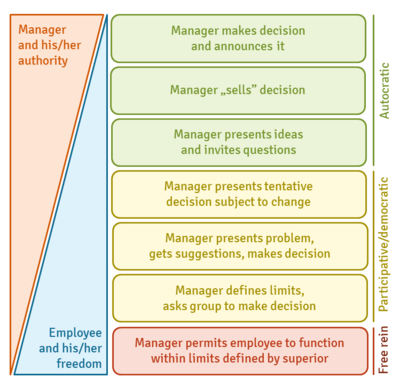Free rein leadership
| Free rein leadership |
|---|
| See also |
A free-rein or laissez-faire (French for "leave it alone") leadership is a management style in which leaders leave most decisions to their subordinates. Under this approach, leaders assign tasks to employees and give them free rein to choose the best way to complete them. This style also means that leaders do not get involved unless asked and subordinates have unlimited freedom provided that they do not violate existing policies of the company (L. J. Gitman, C. McDaniel 2007, p. 219).
Characteristics of free-rein leadership
The characteristics of the free-rein leadership style are the following:
- faith in employees - it indicates that leaders believe that their subordinates are capable and liable individuals and that is why they have confidence in them,
- independent decision-making system - it means that decisions are made by employees who have a choice whether to consult the leader or not,
- decentralization of authority - it signifies that leaders pass part of their authority to employees, enabling them to state their objectives and plans,
- employees' self-control - it translates into the fact that employees supervise and control each other on their own whereas the leader only intercedes in exceptional or critical situations (A. Gupta 2015, p. 830).
Advantages of free-rein leadership
The free-rein leadership style has a lot of advantages. Some of them are:
- positive impact on job satisfaction and morale of employees,
- maximum development of employees,
- complete utilization of the potential of employees (The Institute of Cost Accountants of India 2014, p. 9.5).
Disadvantages of free-rein leadership
Implementation of this style has also disadvantages, such as:
- employees do not get clear clues and support of the leader,
- leaders contribution is ignored,
- employees can move in different directions and work at cross purposes which may cause chaos (The Institute of Cost Accountants of India 2014, p. 9.5).
Usage of free-rein leadership
The free-rein leadership style is effective especially when:
- employees are well-qualified and experienced,
- employees are proud of their work and willing to complete tasks on their own,
- outside specialist or consultants are being used,
- employees are reliable and trustworthy.
The free-rein leadership style should not be used when employees do not feel secure because of the unavailability of a leader or when the leader is not going to provide regular feedback to employees (A. Gupta 2015, p. 829).
References
- Bagad V. S. (2008), Financial & Industrial Management, Technical Pulications Pune, Pune, pp. 28-29
- Boone L. E., Kurtz D. L. (2010), Contemporary Business 2010 Update Edition, John Wiley & Sons, Chichester, p. 270
- Eagly A. H., Johannesen-Schmidt M. C. (2001), The Leadership Styles of Women and Men, "Journal of Social Issues", vol. 57, no. 4
- Gitman L. J., McDaniel C. (2007), The Future of Business: The Essentials, 3rd Edition, Thomson Shouth-Western, Mason, p. 219
- Gupta A. (2015), Leadership Styles, "International Journal Of Business Management", vol. 2, no. 1., pp. 829-831
- Hess M. J. (2012), Shine! Healthcare Leadership Distilled: Increase Your Bottom-line Through Improved Leadership, AuthorHouse, Bloomington, p. 40
- Mehrotra A. (2005), Leadership Styles Of Principals, Mittal Publications, New Delhi, p. 7
- Odgers P. (2004), Administrative Office Management, Complete Course, South-Western Cengage Learning, Mason, p. 262
- The Institute of Cost Accountants of India (2014), Fundamentals of Economics and Management, Directorate of Studies, Kolkata, p. 9.5
- Žvirdauskas D., Jucevičienė P. (2004), Realtionship between Leaders and Employees in Organizaton: in Search for its Determining Factors, "Socialiniai Mokslai", no. 3(45), p. 86
Author: Klaudia Nycz
